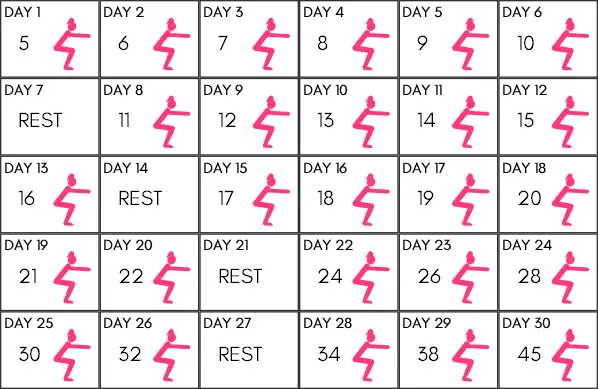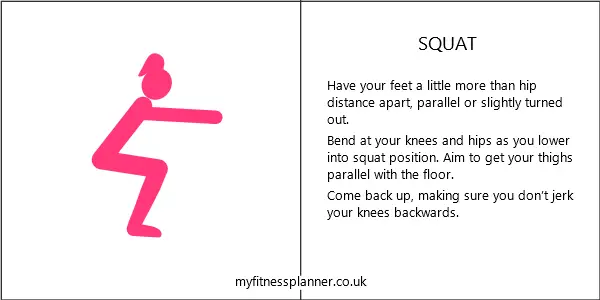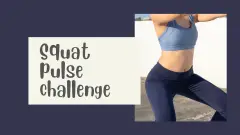Complete 500 squats in 30 days. Squats work all the leg muscles and it’s easy to fit a few minutes of squats into your day. You can do them anywhere and you don’t need much space or a mat. The number of squats adds up to 500 over the course of the month, starting with just 5 on the first day and gradually building up to 45. Once you’ve finished the 500 squats challenge, you could try adding some weight with this squats with kettlebell workout.
500 squats challenge reps
These are the number of squats for each day to make up your 500. The reps increase by 1 each day to start with, but the increases get bigger towards the end of the challenge. Make sure you take the rest days – rest is an important part of fitness. Instructions on how to squat are below the chart.

How to squat

Squatting is a natural movement that we often do in every day life, but to get the most out of the challenge and to avoid injury risk, make sure you follow all the technique points above. Don’t worry if you can’t get your thighs down to parallel with the floor – not everyone can.
Also make sure you’re wearing loose or stretchy clothing to allow you to squat as low as you are able. You can squat barefoot, in socks or in flat shoes. However, be careful not to have footwear than can slip if you’re squatting on a smooth floor.
Please read these general exercise safety notes before starting the challenge.
Squatting with good technique
Performing squats with proper form is important in order to enjoy maximum benefits of the exercise and minimize the risk of injury. Here’s why having good technique when doing squats is essential:
Enhanced Muscle Engagement: Proper squat form ensures that the target muscles, including the quadriceps, hamstrings, glutes, and core, are engaged effectively. This leads to improved muscle strength, tone, and endurance.
Injury Prevention: Improper squat form can strain the lower back, knees, and ankles, increasing the risk of injury. Maintaining a neutral spine, keeping the knees aligned over the toes, and avoiding excessive weight bearing on the toes are key to injury prevention.
Effective Movement Patterns: Squats are a fundamental movement pattern that translates into everyday activities, such as climbing stairs, getting up from a chair, and lifting objects. Proper squat technique helps develop these movement patterns correctly, enhancing overall functional movement.
Optimal Weight Distribution: Proper squat form ensures that weight is evenly distributed throughout the feet, preventing strain on specific areas. This promotes stability, balance, and alignment.
Increased Range of Motion: Proper squat form allows for a full range of motion, promoting flexibility and mobility in the hips, knees, and ankles. This can help prevent stiffness and reduce pain in these joints.
Related to 500 squats challenge
Challenge FAQs
The first day of the challenge should feel like it needs a bit of effort, but not too much. If you really struggle with day 1, then you probably won’t get through the challenge. The idea with the challenges on this site is that the first few days get you used to the exercises and the daily habit. Usually about halfway through the challenge the effort levels start to increase more quickly.
Avoid challenges that increase effort levels very quickly – they’re simply not realistic. It’s unlikely that, for example, you would be able to increase how many squats you are able to do by 10 a day for 30 days, or increase your plank hold time by 10 seconds a day for 30 days.
Last Updated on: April 24, 2022In general, allowing muscles 48 hours between workouts is good because it gives our bodies time to recover and adapt. Challenges are generally short workouts and for a limited period of time (usually 30 days), so not having many rest days won’t be a problem. With challenges that alternate exercises each day, it’s not an issue, because you’re using different muscles.
Last Updated on: April 24, 2022Fitness improvements don’t always happen in a predictable way. Sometimes we’re just not as strong or energetic for no apparent reason, or we hit a plateau. If you get to a point where you’re struggling to complete the day’s challenge, you can try one of the following:
- Take a couple of days off and start again where you left off
- Do the challenge on alternate days rather than every day
- Instead of increasing the effort every day, stay at the same level for 2 or 3 days and then go onto the next day of the challenge
Obviously these solutions mean the challenge will last longer, but you’ll still benefit from doing it.
Last Updated on: April 24, 2022
